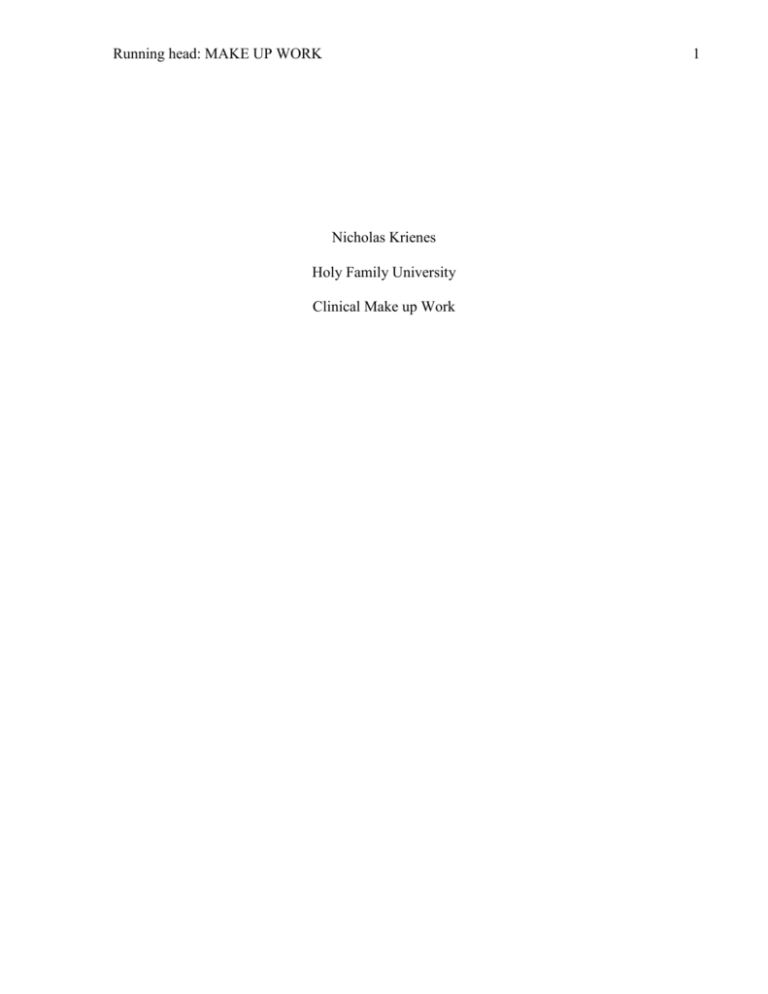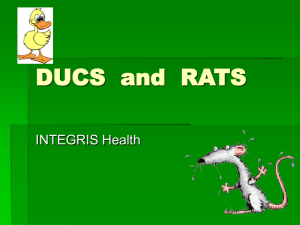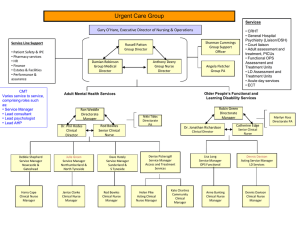WORD - Rowan University
advertisement

Running head: MAKE UP WORK 1 Nicholas Krienes Holy Family University Clinical Make up Work Running head: MAKE UP WORK Case Study Pain Management #1 Mr. Rogers is two days post-operative of a thoracotomy for removal of a malignant mass in his left chest. His pain is being managed via an epidural catheter with Morphine (an opioid analgesic). As the nurse assumes care of Mr. Rogers, he is alert and fully oriented, and states that his current pain is 2 on a 1 – 10 scale. His vital signs are 37.8 – 92 – 12, 138/82. What are benefits of epidural versus systemic administration of opioids? The benefits of epidural versus systemic administration of opioids are there is less of a chance of getting an infection, it is quickly and easily placed, and it is least invasive. In systemic administration of opioids there is a risk for a rapid infusion or a blous of the drug which can lead to the drug reaching toxic levels much faster in the patient. If this happens then the patient will have manifestations such as dizziness, angina, possible loss of consciousness which could lead to shock and cardiac arrest. The nurse monitors Mr. Rogers’ respiratory status and vital signs every 2 hours. What is the rationale for these frequent assessments? The rationale for these frequent assessments is that morphine is being administered rather than Fentanyl which puts Mr. Rogers at a greater risk for respiratory depression. Morphine is preferred over Fentanyl for severe pain relief: which in this case is the thoracotomy. The risk for respiratory depression is the main reason why his respiratory status must be checked every two hours. If a decrease in respiratory status occurs, then the nurse needs to report them to the health care provider. Respiratory depression can occur 12 hours or longer post op with morphine rather than Fentanyl. A low respiratory rate means that there is respiratory depression, which means vital signs need to be assessed frequently. The nurse monitors Mr. Rogers for what other complications of epidural analgesia? Some other complications that can occur during epidural analgesia are baselines can become incorrect and unreliable over time, meningitis, nausea/vomiting, pruritus, high risk of bleeding if taking an anticoagulant (LWMH, Heparin, etc), urinary retention, and possible hematoma. If Mr. Rogers’ baselines become inaccurate, it would be difficult to truly know if he is within or outside his true normal baselines. Mr. Rogers complains of a severe headache. What should the nurse do? Since Mr. Rogers is complaining of a severe headache, this could be a sign of Cerebrospinal fluid leakage. The nurse should treat him by keeping him on bed rest or buy applying an epidural blood patch. An epidural blood patch is injecting the patient’s own blood back into the site of leakage to cause a clot so the leak can be sealed off. Mr. Rogers’ epidural morphine and decreased mobility increase his chances of constipation. What interventions should be included in his plan of care to minimize constipation? A couple of interventions that should be included in Mr. Rogers’ plan of care to minimize constipation are to start him on a diet of high fiber, increase the amount of fluid 2 Running head: MAKE UP WORK he is drinking to about 2-3L a day, get him to ambulate as soon as possible and as tolerated, and get a stool softener medication (i.e.; Docusate Sodium) prescribed for him. If Mr. Rogers eats foods such as broccoli, bananas, apples, beans, and carrots, he will be increasing his fiber intake, which can allow him to have a bowel movement. Case Study Pain Management #2 Mr. Will is 67 years of age and is a male patient who is postoperative day 2 after a coronary artery bypass graft operation to re-vascularize his coronary arteries that were significantly blocked. He has a midline incision of his chest, and a 7-inch incision on the inner aspect of his right thigh where a saphenous vein graft was harvested and used to vascularize the blocked coronary artery. The surgeon ordered Tylenol with Codeine No. 3, 1 to 2 tablets every 4 to 6 hours as needed for discomfort. Considering the patient’s age, what medication administration considerations should the nurse incorporate into the pain management plan and why? Considering Mr. Will’s age, the medication administration considerations the nurse should incorporate into the pain management plan are that he should take morphine instead of Tylenol with Codeine No. 3. Morphine can decrease his pain more effectively and there would be less of a dosage administered considering that Morphine is a stronger acting opioid.. Since Mr. Will is considered as an older adult, the nurse should consider and incorporate into the pain management plan that he should be given less medicine compared to a middle-aged adult. The nurse would monitor his vital signs more often to ensure that there are no signs of respiratory depression. Giving him morphine over the Tylenol will lessen the load of medicine he takes and decrease the need of metabolism of the drug. What measures should the nurse provide the patient to prevent adverse effects of analgesic agents from occurring? A couple of measures the nurse should provide the patient to prevent adverse effects of analgesic agents from occurring are encouraging the patient to splint, cough, turn, and take deep breaths, encourage him cough up sputum if able, help him ambulate frequently. The nurse should monitor for decreased cardiac output, pain, decrease oxygen saturation and dysthymias. By providing and helping the patient with these measures, he can prevent adverse effects of analgesic agents from happening. Case Study Management of Patient With Pneumonia Harry Smith is 70 years of age and a male patient who is admitted to the medical-surgical unit with acute community acquired pneumonia. He was diagnosed with paraseptal emphysema three years ago. The patient smoked cigarettes 1 pack per day for 55 years 3 Running head: MAKE UP WORK and quit three years ago. The patient has a history of hypertension, and diabetes controlled with oral diabetic agents. The patient presents with confusion as to time and place. The family stated that this is a new change for the patient. The admission vital signs are as follows: BP 90/50, P 101, R 28, and T 101.5 °F. The pulse oximeter on room air is 85%. The CBC is: WBC 12,500, platelets 350,000, HCT 30%, and Hgb 10 g/dL. ABGs on room air are: pH 7.30, PaO2 55, PaCO2 50, HCO3 25. Chest x-ray results reveal right lower lobe consolidation, presence of apical bullae, flattened diaphragm, and a small pleural effusion in the right lower lobe. Lung auscultation reveals severely diminished breath sounds in the right lower lobe and absence of breath sounds at the base. The breath sounds in the rest of the lungs are slightly decreased. The patient complains of fatigue and shortness of breath and cannot finish a short sentence before the respiratory rate increases above the baseline and his nail beds and lips turn a bluish tinge and the pulse oximetry decreases to 82%. The patient is diaphoretic and is using accessory muscles. The patient coughs weakly, but he does not raise any sputum. What nursing assessment findings support the diagnosis of pneumonia? A few nursing assessment findings that support the diagnosis of pneumonia are fever, smoking history of 55 years, fatigue, high respirations at 28, diminished breathe sounds in the right lower lobe, absent sounds at the base, and confusion. Having a fever can mean that there is an infection in the body. The Ignatavicius Medical-Surgical book states that confusion is one of the main signs of pneumonia. What diagnostic findings support the diagnosis of pneumonia? Some diagnostic findings that support the diagnosis of pneumonia are high WBC levels at 12,500, a right lower lobe consolidation seen in a chest x-ray, and respiratory acidosis. Considering Mr. Smith has a high WBC level, that can support and show a possible infection being in Mr. Smith’s body. Since his pH is low at 7.30 and his PaCO2 is high at 50mmHg, this is an indication for respiratory acidosis. What nursing diagnoses should the nurse formulate for the patient? Two nursing diagnoses the nurse should formulate for the patient are, 1) Risk for infection d/t fever and increased WBC and Decreased H&H. This shows that the body is fighting off an infection which in this case is the consolidation in the lungs(RLL). The decreased H&H shows the body is immunosuppressed, making the body susceptible for bacteria to invade. 2) Impaired gas exchange r/t respiratory acidosis as evidenced by ABG levels. The impaired gas exchange r/t respiratory acidosis AEB ABG levels proves that his CO2 levels are high and his O2 levels are low, which can cause shortness of breath and hyperventilation. What goals should the nurse develop for the patient? A few goals the nurse should develop for the patient are increasing the oxygen levels and decreasing the carbon dioxide levels. This could decrease confusion to orient the patient AAOx3. Oxygen administration should be given via NC for proper oxygenation. Administering oxygen to the patient should be efficient in maintaining saturated oxygen 4 Running head: MAKE UP WORK levels at least 90%-95%. More breathing techniques should be used such as the incentive spirometer. This could make the patient have an easier time in able to get the mucus moved around or out of the lungs. What overall interventions should the nurse provide? Considerations in teachings to the patient should be coughing, deep breathing, how to use the incentive spirometer (10 times per hour), and increase fluids to liquefy secretions in order to make them easier to excrete. Orientation of patient to person, place and time in order to decrease confusion should be done every time the patient is in contact with another individual. Ambulation should be done ass tolerated in order to open up lung fields and assist with flattened diaphragmatic movement. This will give the patient a chance to take more breathes and to move around consolidations. 5 Running head: MAKE UP WORK References Ignatavicius, D. D., MS, RN, ANEF, & Workman, M. L., PHD, RN, FAAN. (2013). Medical Surgical Nursing (7th ed.). St. Louis, MO: Elsevier Saunders. Epidural.net. (n.d.). What is a blood patch?. Retrieved February 26, 2014, from http://www.epidural.net/blood-patch.htm 6







